- About us»
- Net income calculator»
- Population aging»
-
- Least developed regions»
-
- Material need benefits
- Meal allowance
- Counties of Slovakia
- Average wage and inflation
- Living and Subsistence Minimum
- Unemployment of Czechia and Slovakia
- NACE Classification
-
- Life expectancy
- Gender differences
- Youth unemployment and NEET
- Minimum wage in EU
- Unemployment rates of different age groups
- Share of salaries on GDP
- Employment of mothers of more than 3 children
- Percentage of employees ususally working on Sunday
- Percentage of employees ususally working at nights
- Unemployment rate
- NEET
- Long term unemployment
- Employment rate
-
- Bratislava and surroundings
- Kopanice
- Danube river
- lower Vah river
- middle Vár river
- upper Nitra river
- lower Nitra river
- Mining cities
- Kysuce a Orava
- upper Vah river - Liptov
- Spiš cities
- upper Hron river
- Juhoslovenská kotlina
- Košice fold and Torysa river
- upper Zemplín
- lower Zemplín
- EU regions
- NUTS3 regions of Slovakia
- LAU1 dataset
-
- Projects and activities
- Inclusive growth»
- Good work
- Project SKRS
- Social system – reality and vision
- Library
-
- Education of unemployed
- Young unemployed not taking part in education
- Proposal to change the system of education funding
- News»
- Contact
Aragon – ES24
EU regions: Spain > Noreste > Aragon
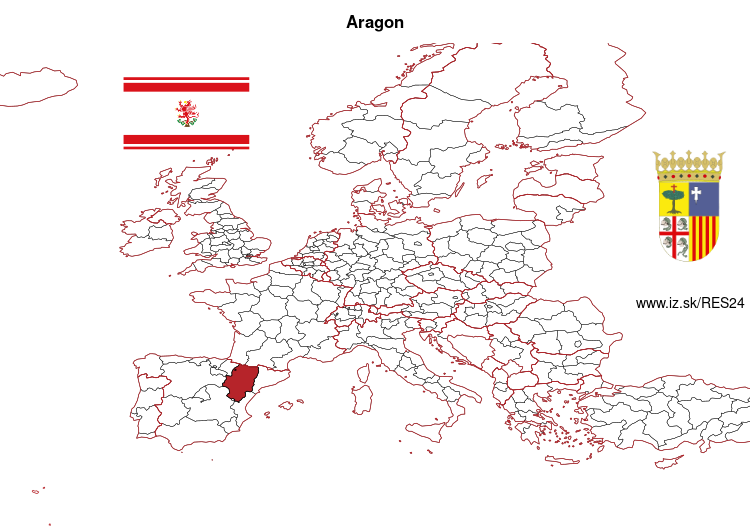
| Indicator | Period | Value |
|---|---|---|
| Life long learning | ||
| life long learning participation | 2022 | 15.9 |
| Part time jobs and flexible employment | ||
| percentage of part time workers | 2022 | 12.83 |
| percentage of part time workers, men | 2022 | 3.66 |
| percentage of part time workers, women | 2022 | 23.37 |
| Gender differences | ||
| gender gap in employment rate | 2022 | 86.79 |
| gender gap in unemployment rate | 2022 | 150 |
| Graduates and young people | ||
| unemployment rate of youth with elementary education | 2022 | 38.9 |
| NEET | 2022 | 7.9 |
| Gross domestic product | ||
| GDP per capita in PPS of EU average | 2022 | 94 |
| Employment | ||
| employment rate | 2022 | 69.3 |
| Social exclusion | ||
| people at risk of poverty or social exclusion | 2020 | 18.5 |
More on wikipedia wikidata Q4040 on OpenStreetMap Aragon slovensky: ES24
Subregions: Huesca Province, Teruel Province, Zaragoza Province
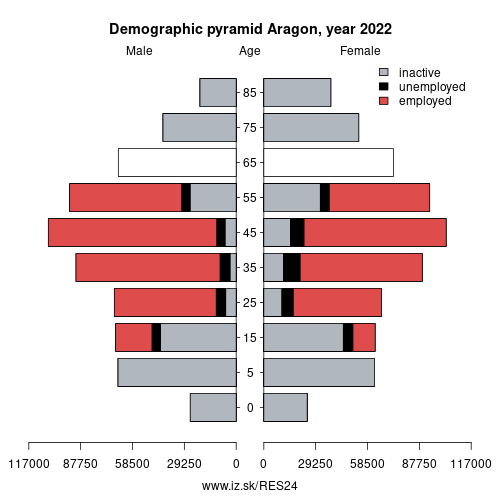
Unemployment
| Indicator | Period | Value |
|---|---|---|
| Unemployment | ||
| unemployment rate | 2022 | 9.5 |
| youth unemployment rate | 2022 | 24 |
| Long term unemployment | ||
| long term unemployment | 2022 | 2.9 |
| share of long term unemployed | 2022 | 30.6 |
Demographics
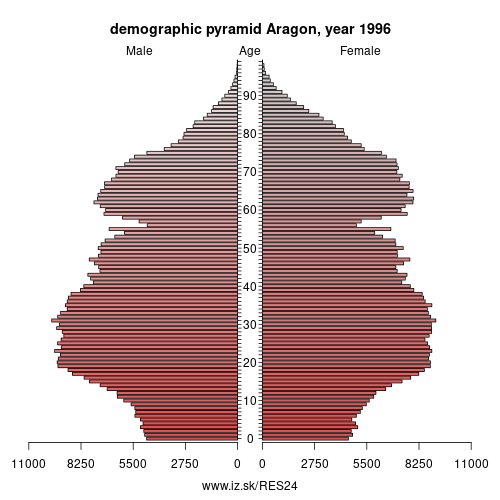
| Indicator | Period | Value |
|---|---|---|
| Demographics | ||
| number of inhabitants | 2023 | 1.341289e+06 |
| population density | 2022 | 28 |
| old-age dependency ratio | 2023 | 34.3 |
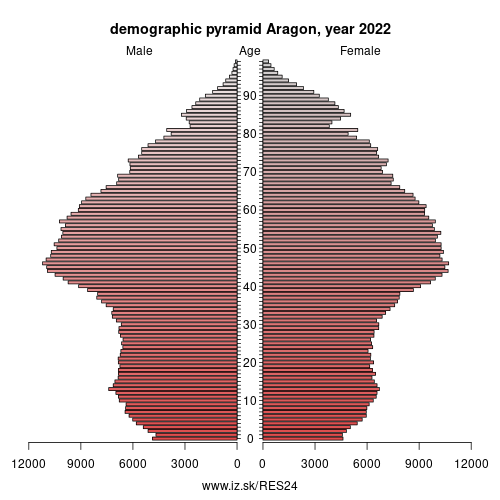
Employment by sectors, Aragon
| NACE r2 | % | NACE r2 | % | ||
|---|---|---|---|---|---|
| A | 33.1 | 6 % | B-E | 109.9 | 19 % |
| F | 37.9 | 6 % | G-I | 144 | 25 % |
| J | 12.5 | 2 % | K | 10.2 | 2 % |
| L | 3.2 | 1 % | M_N | 51.6 | 9 % |
| O-Q | 145 | 25 % | R-U | 37.3 | 6 % |
| TOTAL | 584.7 | 100 % |
Data for the period year 2022. Source of the data is Eurostat, table [lfst_r_lfe2en2].
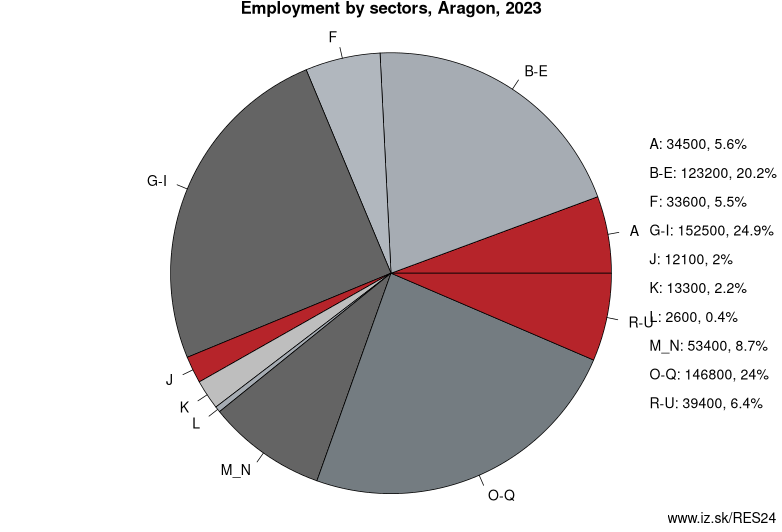
From Wikipedia: Aragon ( or , Spanish and Aragonese: Aragón [aɾaˈɣon], Catalan: Aragó [əɾəˈɣo]) is an autonomous community in Spain, coextensive with the medieval Kingdom of Aragon. Located in northeastern Spain, the Aragonese autonomous community comprises three provinces (from north to south): Huesca, Zaragoza, and Teruel. Its capital is Zaragoza (also called Saragossa in English). The current Statute of Autonomy declares Aragon a historic nationality of Spain.
Covering an area of 47720 km2 (18420 sq mi), the region's terrain ranges diversely from permanent glaciers to verdant valleys, rich pasture lands and orchards, through to the arid steppe plains of the central lowlands. Aragon is home to many rivers—most notably, the river Ebro, Spain's largest river in volume, which runs west-east across the entire region through the province of Zaragoza. It is also home to the highest mountains of the Pyrenees.
As of January 2016, the population of Aragon was 1308563, with over half of it living in its capital city, Zaragoza. During the same year, the economy of Aragon generated a GDP of €34687 million, which represents 3.1 % of Spain's national GDP, and is currently 6th in per capita production behind Madrid, Basque Country, Navarre, Catalonia and La Rioja.
In addition to its three provinces, Aragon is subdivided into 33 comarcas or counties. All comarcas of Aragon have a rich geopolitical and cultural history from its pre-Roman, Celtic and Roman days, and four centuries of Islamic period as Marca Superior of Al-Andalus or kingdom (or taifa) of Saraqusta, and as lands that once belonged to the Frankish Marca Hispanica, counties that later formed the Kingdom of Aragon and eventually the Crown of Aragon.
Other: Noreste, La Rioja, Navarre, Aragon, Basque Autonomous Community
Neighbours: Navarre, Castile and León, La Rioja, Aquitaine, Castile-La Mancha, Midi-Pyrénées, Valencian Community, Catalonia
Subregions: Huesca Province, Teruel Province, Zaragoza Province
Suggested citation: Michal Páleník: Europe and its regions in numbers - Aragon – ES24, IZ Bratislava, retrieved from: https://www.iz.sk/PES24, ISBN: 978-80-970204-9-1, DOI:10.5281/zenodo.10200164

 Share
Share Facebook
Facebook Twitter
Twitter News
News